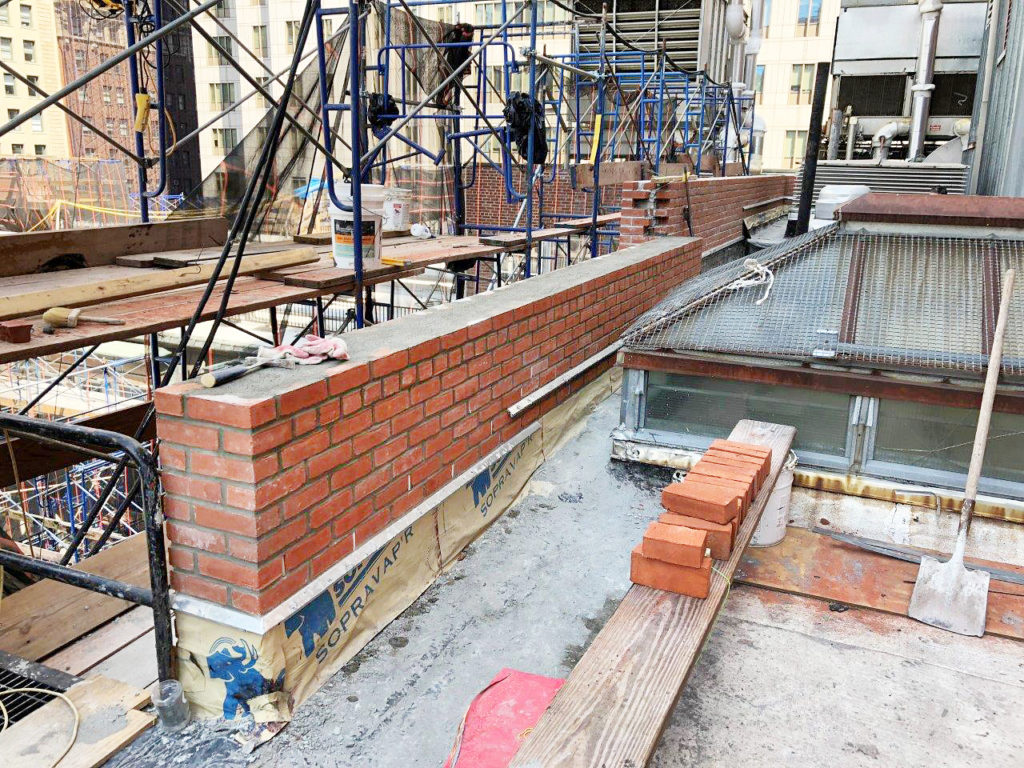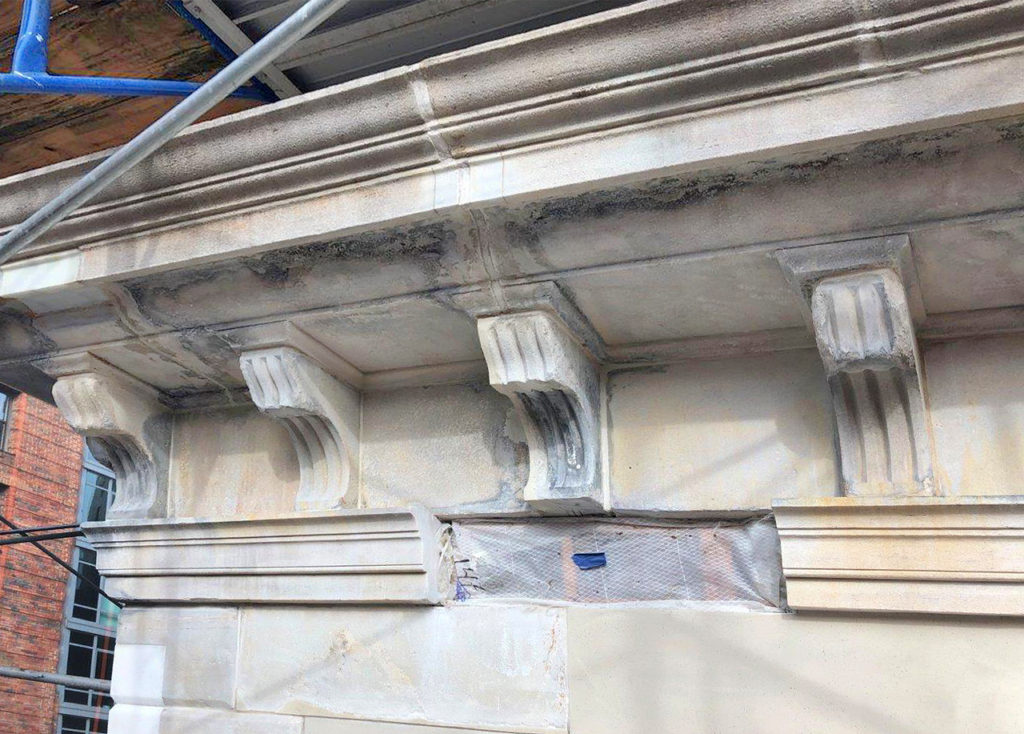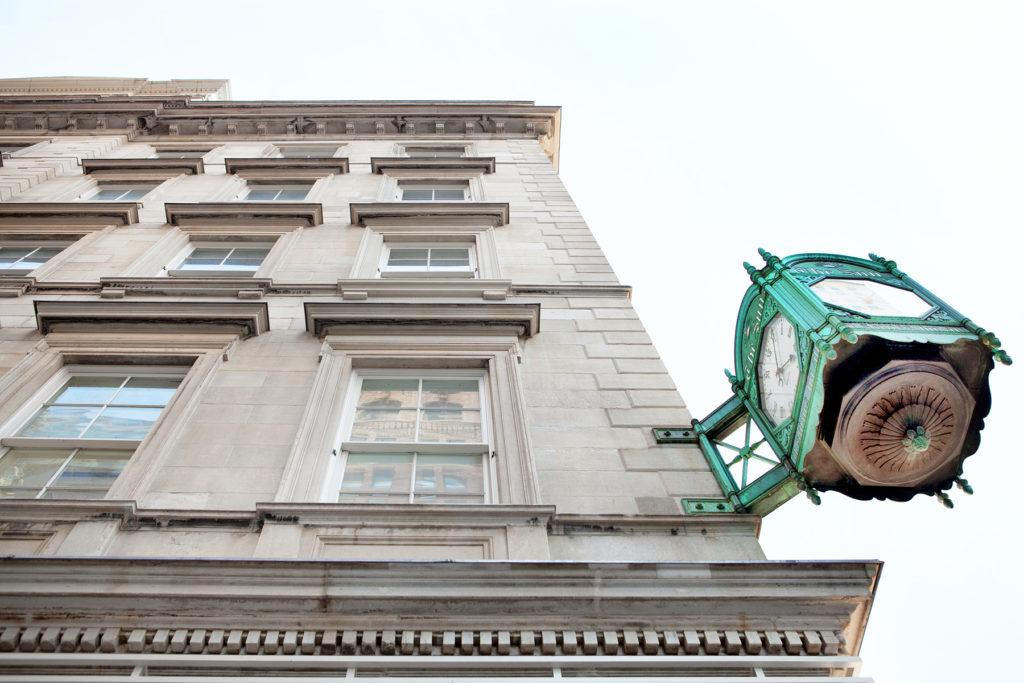Words: Vanessa Salvia
Photos: Ola Wilk, Antonio Pinto
When quarries close, that leaves restorers needing to find the “next best thing” to the pristine marble that was originally used on a building’s facade. That’s the predicament a team of restorers in New York City found themselves in when they embarked upon a historic restoration of the landmark Sun Building, also known by its address at 280 Broadway.
A team of people $17.5 million to restore this building’s historic facade. The Sun Building, so-named for The New York Sun newspaper that once claimed it as its headquarters, was built in 1846 as New York City’s first department store. It was the city’s first commercial building designed in the Italianate style and the first commercial structure in the city to be clad in Tuckahoe marble.
The restoration, done by Urbahn Architects, the New York City Department of Design and Construction (DDC), the Department of Citywide Administrative Services (DCAS), historic conservator Jablonski Building Conservation, construction manager Jacobs, and contractor Lo Sardo General Contractors won a 2020 Lucy G. Moses Preservation Award from the New York Landmarks Conservancy. The Lucy G. Moses Awards are the New York Landmarks Conservancy’s highest honors for preservation excellence.
By the time the decision was made to restore the building, the Tuckahoe marble quarry had long been mined out. That required some intense marble comparison, deep cleaning, and alterations of the Georgia marble that was used in its place. Inspections of the original marble revealed that the veining ws causing the marble to deteriorate. Dutchman repairs were used in some places, as was replacements of whole panels of marble. An interior courtyard of this U-shaped building required expensive brick masonry restoration. The marble supplier was PolyCor, and Lo Sardo used its own labor for the masonry work.

Natale V. Barranco, AIA, LEED AP, Urbahn’s principal in charge, said challenges included the sheer size of the project, its location in a busy pedestrian-heavy commercial center of the city, and tenants actively using the building. “We organized the work around three phases to ensure minimal interruptions to street traffic and operations of the building’s tenants,” he says. “In addition, some of the cornices that need to be replaced or replicated weigh 400 pounds each, so significant planning to protect pedestrians was required.”
Several Firsts For the City
280 Broadway is a seven-story, 240,000-square foot building located between Chambers and Reade Streets in the Civic Center district of Manhattan. Some of the building’s tenants include several city agencies, including the Department of Buildings. Over the years, the building had fallen into disrepair. A “sidewalk shed” was erected in 1996 and was never taken down, until now. The sheds are required to be erected over sidewalks to protect pedestrian walkways. They are a common site around older New York City buildings, where they are erected not only during construction but also when there’s some danger of debris falling off the buildings and landing on any unsuspecting passers-by. The sheds have been a ubiquitous part of the New York City street scene since the 1979 death of Grace Gold, a Barnard freshman who was struck by a chunk that fell off of a building on West 115th Street.
In 1846, a businessman named Alexander Turney Stewart conceived of the notion of a department store. He operated a small lace and linens shop out of a wooden building at 283 Broadway, between Church and Reade streets. To implement his idea of a new shopping emporium, Stewart purchased the building known as Washington Hall, which was across the street and had been used for many years as a hotel.
After paying $70,000 for the property, it was cleared for development of the A.T. Stewart Company building. Originally designed as a five-story building, Stewart’s edifice quickly became known as “The Marble Palace.” The store quickly became “the” place for the well-heeled citizenry to shop. A rotunda decorated with wall and ceiling frescoes and dominated by a 70-feet glass dome 80 feet above the floor, ornate chandeliers, expansive mirrors, walls of windows letting in abundant natural light was more than anything shoppers had seen before.

An article in The Evening Post described the constant stream of carriages approaching and leaving his building as a vision akin to an unbroken file of angels ascending and descending a marble Jacobs Ladder to the heavens.
In 1862, Stewart turned some of his success from The Marble Palace into a second, even larger eight-story store a few blocks away, on Broadway between East 9th and 10th Streets. After Stewart’s death in 1876, the 280 building was taken over by Stewart’s estate manager. Its tenants were vacated, and the building was empty for a while. Some of the tenants moved to the second location, and more or less, 280 Broadway remained vacant until 1884. In the 1890s the city moved several of its departments into the building. In 1917, Frank A. Munsey, owner of the New York Herald and The Evening Sun, purchased the building.
In 1951 plans commenced to modernize that corner with a 40-story skyscraper, but that never happened. In 1966 the city took possession of the building after it fell into disrepair and was condemned. That never happened, and again, it survived.
A National and Local Landmark
More than a hundred years after it was first built, it was designated a national landmark in 1965 and a New York City landmark in 1986. When The Sun newspaper claimed it as headquarters, they installed a clock on the Broadway corner of the building which still stands. From that clock, which said “The Sun… It Shines for All,” the building got its nickname as The Sun Building. The building is now owned by New York City and houses governmental offices, with retail tenants on the first floor. It is located across from City Hall Park and occupies a very prominent location in downtown Manhattan.
A New York City mandate known as Local Law 11 (now called the Facade Inspection Safety Program or FISP) requires inspection of buildings over six stories every five years. When the inspectors got to the Sun Building, they found a crumbling facade and a deteriorating roof. Rather than repairing the building just enough to make it to the next five-year inspection, several city departments rallied to perform a comprehensive renovation instead. The goal of the Urbahn team was to renovate the historic facade, while observing strict landmark preservation standards.
“In keeping with the historic nature of this building, everyone decided that this should be more than just a Local Law 11 project,” says Barranco. “The objective became bringing it to a state of excellence through restoration worthy of its history,”

The marble clearly represented a challenging part of the project. Antonio Pinto, AIA, Urbahn’s architect on the project, spent hours on a 125-foot boom inspecting each marble panel with an acrylic hammer. The 55,250-square foot facade extends 200 linear feet along Chambers Street, 225 linear feet along Reade Street, and 151 linear feet along busy Broadway. The entire facade is 85 feet high by 650 feet long, and every inch was inspected. Each panel is about 18 inches by 3 feet.
“You can’t tell if the marble is good when looking at it from the ground,” Pinto says. “After we inspected it we realized that a lot of it had to be replaced. It was the veining in the marble itself that was causing the failure.”
Not only that, Barranco says, but the anchors that were holding the panels on to the building had rusted. From the ground, the panels looked aligned, but up close on the boom, the deterioration was clear.
Matching the Marble
With the Tuckahoe quarries no longer open, Pinto and the team from the Jablonski Building Conservation had to try to find a matching marble. Tuckahoe marble is a type of marble found in southern New York state and western Connecticut. It varies in shade from veining of light gray to light green and a bluish or bright white substrate. The marble mined from the village of Tuckahoe is considered very high quality. Its proximity to New York City ensured that it was used on numerous federal buildings throughout New York, Washington D.C., and Rhode Island.
Their search for a replacement led them to George marble. The Georgia marble though, is more veined than the original Tuckahoe. “We had to scour through the marble for ones that had the least amount of veining and the least amount of dark veining that we could find,” Pinto says. “One of the big things we wanted to avoid was creating a patchwork quilt look.”
Much of the replacement marble was too white, so it was stained in a delicate process to match the slightly off-white color of the original. The three-part process started with splattering and speckling the marble with some black stain, a product called PBS Chem Bond 2000, PBSN Silicate, to make it match more closely the original off-white marble. Not only that, but in the mid-1990s, New York City architecture firm Beyer Blinder Belle had overseen some renovations to the building. They also attempted marble replacement and staining, but over the ensuing years much of that stain had washed off the building, so Urbahn had to match not only the original marble but the circa-mid90s replacement marble while not staining the original marble. Black carbon staining from the previous renovation was removed, but not entirely as some carbon was embedded in the stone.
“We went through a bunch of tests and tried several different methodologies before coming up with the final solution,” says Barrancas.

When acidic compounds such as rainwater and polluted air react with the calcite in marble and limestone, the calcite dissolves. This can result in rough surfaces and loss of details. Sometimes, a black crust of gypsum forms, which can be washed away. The first thing they did was give the original marble a deep clean. “Due to pollution over the years we wanted to get the original marble as clean as possible,” says Pinto. “We tried about 20 different cleaning products, including just using water.”
Replacing some of the marble panels wasn’t as easy as they thought it would be. As much of the original marble as possible was kept, but when replacements had to be made, the material was hand-selected at the quarry. The team also performed dutchman repairs, which are done on severely cracked marble blocks by cutting out the fault in a stone and then insetting new stone material to match adjacent material as closely as possible. Pinto says they realized that some of the panels had shifted on one corner of the building that had settled.
“The masons had decided to grind down the panel that had heaved a little bit and it allowed us to slide the new panel in place more properly,” says Pinto. “They did such a nice job you couldn’t even tell it was done like that.”
About Urbahn Architects
Urbahn Architects is a full-service planning and design firm based in New York City. Since its founding in 1945, the firm has designed projects for some of the nation’s most iconic structures, including the Vehicle Assembly Building and Launch Control at Kennedy Space Center in Cape Canaveral, Florida, and the Fermi National Accelerator Lab in Batavia, Illinois. Urbahn’s other recent project for DCAS and DDC, the restoration of the Surrogate’s Courthouse skylight at 31 Chambers Street in Manhattan, has also won this year’s Lucy G. Moses Preservation Award. The Lucy G. Moses Awards are the New York Landmarks Conservancy’s highest honors for preservation excellence.













